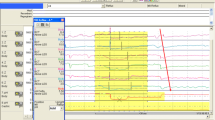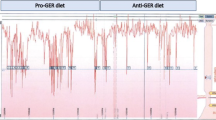Abstract
The aim of this study was to investigate the day-to-day reproducibility of 24-hr esophageal pH monitoring. The procedure was performed continuously for 48 hr in order to enable future studies on dietary challenges, using consecutive 2 × 24 hr pH recording. Furthermore, one objective was to relate the degree of reproducibility to endoscopic evidence of mucosal injury. Upper endoscopy and 2 × 24-hr consecutive pH monitoring were performed in 30 infants and children referred for gastroesophageal reflux disease. The monitoring was performed without dietary or activity restrictions in order to assess reflux parameters in a near-normal physiologic setting. The NASPGHAN criteria for pathological reflux index (RI, % fraction of time with pH < 4.0) were employed. Based upon the NASPGHAN criteria for the RI, 9/30 subjects (30%) had discordant (normal vs pathologic) results at the two recording days, yielding an overall reproducibility of 70%. The limits of agreement for RI at day 2 were 0.2–3.3 times the initially obtained value at day 1. No difference was found in terms of reproducibility between groups with and without esophageal mucosal changes (erythema and esophagitis). No significant difference was noted in the association between pH monitoring and macroscopic esophageal mucosal changes between the two recordings days. In conclusion; a considerable intraindividual variability in reflux parameters was observed between the measurements from day 1 to day 2. This physiologic variability should be taken into consideration when evaluating gastroesophageal reflux disease in infants and children by means of pH monitoring. The day-to-day variability limits the use of simultaneous pH monitoring and dietary challenges as a procedure to identify a possible causative relation between GERD and dietary allergy/intolerance.
Similar content being viewed by others
REFERENCES
Orenstein SR, Izadnia F, Khan S: Gastroesophageal reflux disease in children. Gastroenterol Clin North Am 28:947–969, 1999
Orenstein SR: Update on gastroesophageal reflux and respiratory disease in children. Can J Gastroenterol 14:131–135, 2000
Stordal K, Nygaard EA, Bentsen B: Organic abnormalities in recurrent abdominal pain in children. Acta Paediatr 90:638–642, 2001
van der Meer SB, Forget PP, Kuijten RH, Arends JW: Gastroesophageal reflux in children with recurrent abdominal pain. Acta Paediatr 81:137–140, 1992
Ashorn M, Maki M, Ruuska T, Karikoski-Leo R, Hallstrom M, Kokki M, Miettinen A, Visakorpi JK: Upper gastrointestinal endoscopy in recurrent abdominal pain of childhood. J Pediatr Gastroenterol Nutr 16:273–277, 1993
Rudolph CD, Mazur LJ, Liptak GS, Baker RD, Boyle JT, Colletti RB, Gerson WT, Werlin SL: Guidelines for evaluation and treatment of gastroesophageal reflux in infants and children: recommendations of the North American Society for Pediatric Gastroenterology and Nutrition. J Pediatr Gastroenterol Nutr 32(suppl 2):S1–S31,2001
Vandenplas Y, Loeb H: The interpretation of oesophageal pH monitoring data. Eur J Pediatr 149:598–602, 1990
Wenzl TG, Moroder C, Trachterna M, Thomson M, Silny J, Heimann G, Skopnik H: Esophageal pH monitoring and impedance measurement: a comparison of two diagnostic tests for gastroesophageal reflux. J Pediatr Gastroenterol Nutr 34:519–523, 2002
Vandenplas Y, Goyvaerts H, Helven R, Sacre L: Gastroesophageal reflux, as measured by 24-hour pH monitoring, in 509 healthy infants screened for risk of sudden infant death syndrome. Pediatrics88:834–840, 1991
Arana A, Bagucka B, Hauser B, Hegar B, Urbain D, Kaufman L, Vandenplas Y: pH monitoring in the distal and proximal esophagus in symptomatic infants J Pediatr Gastroenterol Nutr 32:259–264, 2001
Vandenplas Y, Helven R, Goyvaerts H, Sacre L: Reproducibility of continuous 24 hour oesophageal pH monitoring in infants and children. Gut 31:374–377, 1990
Mahajan L, Wyllie R, Oliva L, Balsells F, Steffen R, Kay M: Reproducibility of 24-hour intraesophageal pH monitoring in pediatric patients. Pediatrics 101:260–263, 1998
Iacono G, Carroccio A, Cavataio F, Montalto G, Kazmierska I, Lorello D, Soresi M, Notarbartolo A: Gastroesophageal reflux and cow's milk allergy in infants: a prospective study. J Allergy Clin Immunol 97:822–827, 1996
Lundell LR, Dent J, Bennett JR, Blum AL, Armstrong D, Galmiche JP, Johnson F, Hongo M, Richter JE, Spechler SJ, Tytgat GN, Wallin L: Endoscopic assessment of oesophagitis: clinical and functional correlates and further validation of the Los Angeles classification. Gut 45:172–180, 1999
Bland JM, Altman DG: Statistical methods for assessing agreement between two methods of clinical measurement. Lancet 1:307–310, 1986
Bland JM, Altman DG: Difference versus mean plots. Ann Clin Biochem 34(Pt 5):570–571, 1997
Hampton FJ, MacFadyen UM, Simpson H: Reproducibility of 24 hour oesophageal pH studies in infants. Arch Dis Child 65:1249–1254, 1990
de Caestecker JS: Twenty-four-hour oesophageal pH monitoring: advances and controversies. Neth J Med 34(Suppl):S20–S39, 1989
Franzen T, Grahn LT: Reliability of 24-hour oesophageal pH monitoring under standardized conditions. Scand J Gastroenterol 37:6–8, 2002
Helm JF, Dodds WJ, Hogan WJ, Soergel KH, Egide MS, Wood CM: Acid neutralizing capacity of human saliva Gastroenterology 83:69–74, 1982
Kelly KJ, Lazenby AJ, Rowe PC, Yardley JH, Perman JA, Sampson HA: Eosinophilic esophagitis attributed to gastroesophageal reflux: improvement with an amino acid-based formula. Gastroenterology109:1503–1512, 1995
Ruchelli E, Wenner W, Voytek T, Brown K, Liacouras C: Severity of esophageal eosinophilia predicts response to conventional gastroesophageal reflux therapy. Pediatr Dev Pathol 2:15–18, 1999
Butt AM, Murch SH, Ng CL, Kitching P, Montgomery SM, Phillips AD, Walker-Smith JA, Thomson MA: Upregulated eotaxin expression and T cell infiltration in the basal and papillary epithelium in cows' milk associated reflux oesophagitis. Arch Dis Child 87:124–130, 2002
Ravelli AM, Tobanelli P, Volpi S, Ugazio AG: Vomiting and gastric motility in infants with cow's milk allergy J Pediatr Gastroenterol Nutr 32:59–64, 2001
Author information
Authors and Affiliations
Rights and permissions
About this article
Cite this article
Nielsen, R.G., Kruse-Andersen, S. & Husby, S. Low Reproducibility of 2 × 24-Hour Continuous Esophageal pH Monitoring in Infants and Children: A Limiting Factor for Interventional Studies. Dig Dis Sci 48, 1495–1502 (2003). https://doi.org/10.1023/A:1024703504585
Issue Date:
DOI: https://doi.org/10.1023/A:1024703504585




